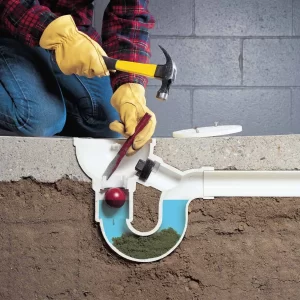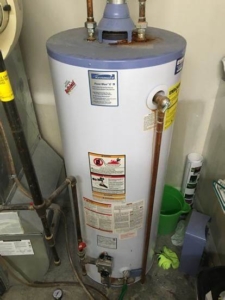Learn What The Water Heater Pressure Relief Valve Is
If you own a water heater, it is important to understand the water heater pressure relief valve. This valve is an essential safety feature in your water heater system that helps prevent explosions and other potential hazards. This blog post will discuss everything you need about the water heater pressure relief valve, including its function, operation, and maintenance.
What is a Water Heater Pressure Relief Valve?
A water heater pressure relief valve is a safety device installed on water heaters to prevent excessive pressure buildup in the tank. It is typically located near the top of the tank and is designed to open automatically when the pressure inside it exceeds a certain level.
Types of Pressure Relief Valves
Two main pressure relief valves commonly used in water heaters are temperature and pressure (T&P) and pressure-only relief valves.
T&P relief valves are designed to open when the temperature or pressure in the tank exceeds a certain level. They are commonly used in residential water heaters and are required by most building codes.
On the other hand, pressure-only relief valves are designed to open only when the pressure inside the tank exceeds a certain level. They are commonly used in commercial water heaters where the temperature is not likely to exceed a safe level.
How Does the Pressure Relief Valve Work?
The water heater pressure relief valve releases excess pressure from the tank. When the pressure inside the tank reaches a certain level, the valve opens, allowing water to escape. This prevents the tank from exploding or causing other damage.
Signs of a Faulty Valve
A faulty pressure relief valve can be dangerous, as it may not open when it should or too often, leading to water waste. Signs of a faulty valve include:
- Water dripping from the valve
- The valve constantly opening and closing
- No water coming out of the valve when it is tested
- Rust or corrosion on the valve
If you notice any of these signs, it is important to have your valve inspected and, if necessary, replaced by a professional.
Why Is the Water Heater Pressure Relief Valve Important?
The water heater pressure relief valve is an essential safety feature in your water heater system. Here are a few reasons why it is important:
- Preventing Explosions: If the pressure inside the tank exceeds a safe level, the tank can explode, causing significant damage and potentially harming anyone nearby. The pressure relief valve helps prevent this from happening by releasing excess pressure.
- Reducing Water Heater Damage: If the pressure inside the tank is too high, it can damage the tank and other components of the water heater system. By releasing excess pressure, the valve helps reduce this risk.
- Ensuring Safety of Home and Occupants: A malfunctioning pressure relief valve can be dangerous. It may not release excess pressure when it should, potentially leading to an explosion or other hazards. Ensuring that the valve works properly helps protect your home’s and its occupants’ safety.
Maintenance and Testing of Pressure Relief Valve
Regular maintenance and testing of your water heater pressure relief valve are essential to ensure it works properly. Here are a few tips for maintaining and testing your valve:
- Regular Inspection: Inspect your valve periodically to ensure it is in good condition and free of rust or corrosion. If you notice any signs of damage or wear, have it inspected and replaced if necessary.
- Cleaning and Flushing: If your valve is clogged with sediment or debris, it may not work properly. Regularly cleaning and flushing the valve can help prevent this issue.
- Replacement of Faulty Valve: If your valve is malfunctioning or shows signs of wear and tear, it is important to have it replaced by a professional. This will help ensure that your water heater system remains safe and functional.
To test your pressure relief valve, follow these steps:
- Turn off the power supply to the water heater.
- Close the cold water supply valve to the tank.
- Open a hot water faucet in your home to relieve pressure in the system.
- Place a bucket or container under the pressure relief valve to catch any released water.
- Pull the valve’s release lever to open the valve.
- Water should flow from the valve and into the bucket. If water does not flow or the valve leaks after releasing the lever, it may need to be replaced.
How to Install a Water Heater Pressure Relief Valve
Installing a water heater pressure relief valve can be relatively simple with basic plumbing knowledge and the right tools. Here are the steps you can follow to install a water heater pressure relief valve:
- Turn off the power supply to the water heater or switch off the circuit breaker to the heater to ensure no electricity flows through the unit.
- Shut off the water supply to the water heater by turning off the cold water inlet valve.
- Locate the old pressure relief valve on the water heater tank. The valve is usually located near the top of the tank and may have a pipe leading away from it.
- Use a wrench or pliers to loosen the fitting that holds the old pressure relief valve in place. Turn the fitting counterclockwise to remove it from the tank.
- Remove the old pressure relief valve from the tank by pulling it out of the fitting.
- Clean the fitting where the old pressure relief valve was located using a wire brush or a piece of sandpaper to remove any rust, debris, or sediment.
- Apply the plumber’s tape to the threads on the new pressure relief valve. Ensure the tape is wrapped around the threads clockwise to ensure it does not unravel when the valve is screwed into the fitting.
- Thread the new pressure relief valve into the fitting by turning it clockwise until it is snug. Do not overtighten the valve, as this could damage the threads.
- Use a wrench or pliers to tighten the fitting that holds the new pressure relief valve in place. Turn the fitting clockwise to secure it to the tank.
- Turn on the cold water supply valve to refill the water heater tank. Open a hot water faucet in your home to allow air to escape from the tank.
- Check the new pressure relief valve for leaks by running your hand over it and checking for any water dripping.
- Turn on the power supply to the water heater or switch on the circuit breaker to the heater to resume electricity flowing through the unit.
Note: Most residential water heater pressure relief valves have a 3/4 inch inlet and outlet, so a 3/4 inch pipe is typically used for installation. The size of the pipe should always be at least as large as the valve inlet and outlet. This ensures the valve can operate properly and release excess pressure from the tank if necessary.
Conclusion: Learn What The Water Heater Pressure Relief Valve Is
In conclusion, the water heater pressure relief valve is an important safety feature in your water heater system. Regular maintenance and testing of the valve can help ensure it works properly and protects your home and its occupants from potential hazards. If you notice any signs of a faulty valve, have it inspected and replaced by a professional? By taking these steps, you can help ensure the safety and functionality of your water heater system for years to come.





